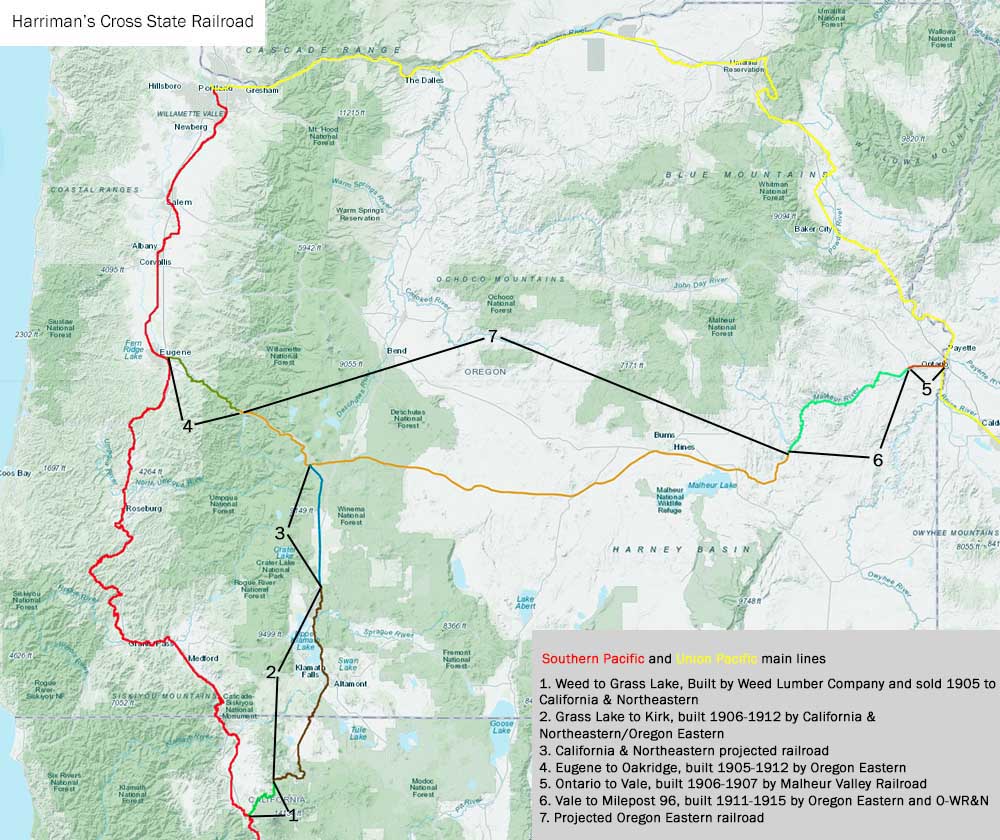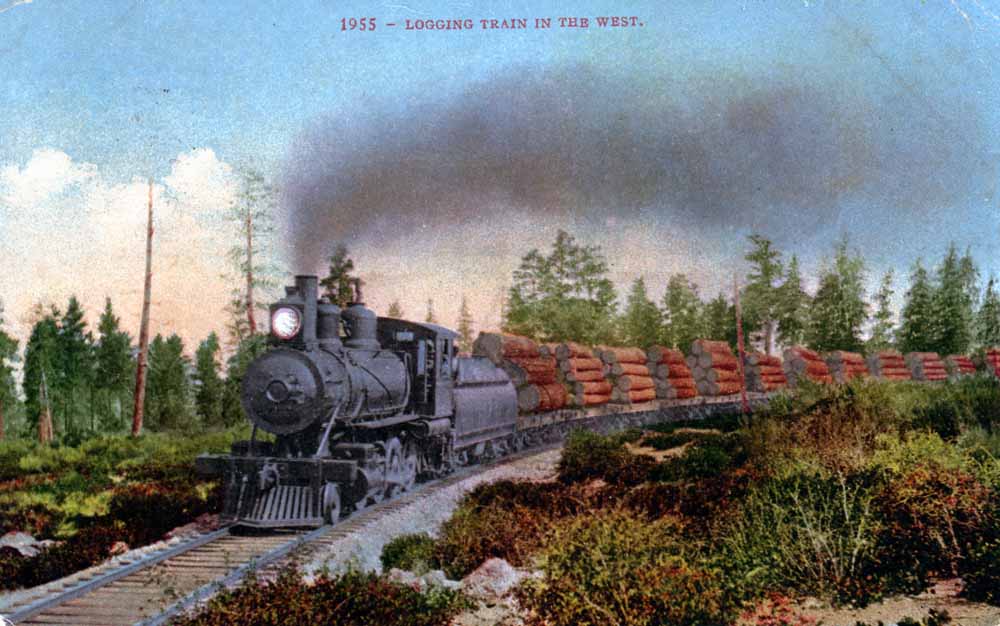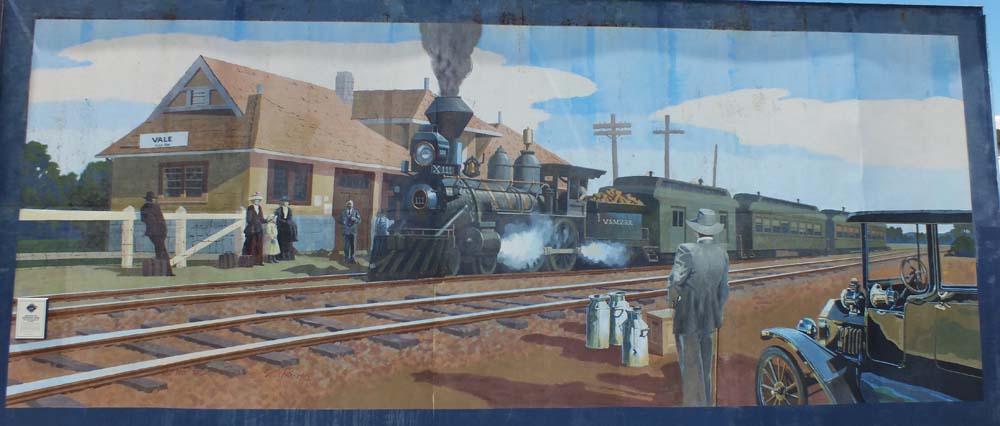|
Harriman's Cross-State Railroad |
|
|
|
Map 
|
|
|
|
One of the last of the true "rail barons" was a man named Edward Henry Harriman. Harriman was born in
Long Island, NY, on 20 February 1848. Tight family finances forced a 14-year old Harriman to quit school
and enter the workforce. Harriman started out running errands for various firms on Wall
Street. The young man apparently had a gift for managing money, as by age 22 he was a member of the
exchange. Harriman first got into the railroad business around 1879. He started out with various railroads
in the northeast and gradually expanded his focus and vision westward. In 1897 Harriman became a director of the Union Pacific Railroad. Within a year he was the director of the railroad's executive committee, and the railroad became his to run. Harriman immediately looked for new opportunities, and he quickly found a great one in the Southern Pacific Railroad. Harriman did not immediately want the entire Southern Pacific system. He initially focused his efforts on trying to buy the Central Pacific, a subsidiary of the larger corporation. The Central Pacific owned a substantial part of the Southern Pacific empire, consisting of the western half of the transcontinental railroad from Ogden, UT, west to San Francisco, and the lines stretching north from the Bay Area to Portland. Harriman thought that the CP would complement the Union Pacific system well, and he offered to buy the CP from the SP. However, SP badly needed the CP lines, and they refused the UP offer. Collis P. Huntington was the last surviving member of the "Big Four" that built the Central Pacific eastward across the Sierras and Nevada/Utah desert in the late 1860s. The CP/SP empire expanded under his direction, and he controlled the company at the time that Harriman's UP made its initial offer. However, the situation changed when Hungtington died on 13 August 1900. Huntington's death gave Harriman the opening he needed. When Huntington's block of SP/CP stock appeared on the markets in March 1901, Harriman made sure that the UP was there to snap it up as fast as it became available, plus any other shares it could find. By the end of March 1901 Union Pacific held a 38% stake in Southern Pacific, which gave the UP a controlling interest in the SP. Harriman immediately set out to weld the two companies together. Much of the Southern Pacific system was in poor shape by this point, and one of Harriman's first acts after gaining control of the company was to pump $240 million into the property. The money financed the re-alignment of much of the original CP/SP system along with many other improvements to the property. One of the major opportunities for improvement that Harriman noticed was in Oregon. The SP had a vast traffic base of forest and agriculture products originating in the Willamette Valley in western Oregon, but to get any of that traffic to the east involved a long journey from Eugene south to Roseville, CA, before traveling east across Nevada and Utah to the UP interchange at Ogden. This route involved crossing many major mountain ranges, and to further complicate operating problems the railroad through southern Oregon was not suited for mainline operations. SP desperately needed a better route to the south and east, and Harriman set out to provide one. SP and UP drew up plans, and by 1905 the two companies were ready to go. The grand plan called for the construction of three new lines: 1. Union Pacific would build a line westward from Ontario, OR, into the Oregon desert. 2. Southern Pacific would build a line eastward from the Eugene, OR, area across Willamette Pass and then out across the Oregon desert to a connection with the UP line building west from Ontario. 3. Southern Pacific would build a second line north from a junction with their original north-south mainline at Weed, CA, through Klamath Falls and then north along the eastern flank of the Cascade Range to a connection with the new east-west trackage outlined above. Completion of these three lines would accomplish several goals. The east-west line across the state would provide the shortest and flattest route for traffic originating in western Oregon bound for the east. Once this traffic reached Ontario it would continue east on the UP mainline across southern Idaho and into Wyoming before joining up with the company's primary main The new north-south line would bypass the tortuous Siskiyou line, giving the SP a vastly superior route for traffic moving between California and Oregon. |
|
|
 An early colorized postcard of a California & Northeastern train hauling logs towards Weed, California. |
|
|
|
Construction on all three of these lines commenced in 1905. On 5 July 1905 Southern Pacific incorporated
the California & Northeastern Railroad to build the line northeast from Weed, and on 21 August 1905
SP incorporated the Oregon Eastern Railroad to build the line east from Eugene. Union Pacific, working through
some local businessmen, incorporated
the Malheur Valley Railroad at about the same time to build the railroad west from Ontario. Construction
on the California & Northeastern and the Malheur Valley started immediately, and both railroads made
good initial progress. The C&NE completed its line to Klamath Falls, OR, in May 1909, with the line
extended to Chiloquin, OR, by 5 July 1911. The railroad reached Kirk, OR, on 6 September 1912. Meanwhile,
the Malheur Valley built westward, with the line from Ontario to Vale placed in operation on 15 January 1907.
The Oregon Eastern finally swung into action in 1910, with the first stretch to Oakridge, OR, completed on
1 May 1912. The company built five miles of grade beyond Oakridge. Meanwhile, in 1911 the Oregon Eastern,
working in conjunction with UP's Oregon-Washington Railroad & Navigation Company, started building west
through the rugged Malheur River Canyon, and reached around Milepost 96 by 1915. This is where things stood when Harriman's
plans fell apart. |
|
|
 A mural featuring a Vale & Malheur Valley Railroad passenger train arriving in Vale. Jeff Moore photo. |
|
|
|
This was the era of the Sherman Anti-Trust Act, and the combined UP-SP system drew strong attention
from the U.S. Justice Department. On 1 February 1908 the U.S. Government filed suit against Union Pacific,
seeking to force that company to divest itself of all interest and ownership in the SP. To further complicate
the issue, Harriman himself died on 9 September 1909. His successors continued to fight the Justice
Department, but to little avail. On 12 December 1912 the U.S. Supreme Courth ruled that UP's control of
the SP did violate the Sherman Act, and the court ordered UP to sell all SP shares that the company owned.
UP did so in early 1913. Harriman's grand plan for a railroad across Oregon died, although
the State of Oregon attempted to force UP to complete the railroad without success for several years
afterwards. The railroads started by the California & Northeastern and Oregon Eastern railroads eventually connected to form Southern Pacific's "Cascade Mainline" between Oregon and California. The Malheur Valley Railroad and the joint OE-OWR&N line went on to become part of Union Pacific's Burns Branch. See both of those pages on this website for the histories of these lines after the end of Harriman's plans. |
|
|
|
References Books "The Southern Pacific in Oregon", Ed Austin and Tom Dill, Pacific Fast Mail, 1987. "Southern Pacific's Shasta Division", John R. Signor, Signature Press, 2000. "When the Railroad Leaves Town: American Communities in the Age of Rail Line Abandonment, Volume 2". Joseph P. Schwieterman, Truman State University Press, 2004. "Main Streets of the Northwest: Rails from the Rockies to the Pacific". T.O. Repp, Trans-Anglo Books, 1989. "Stations West, The Story of the Oregon Railways", Edwin D. Culp, Caxton Printers, 1972. "The American Heritage History of Railroads in America", Oliver Jensen, American Heritage Publishing Co., Inc, 1975. |
|
|
|
More on the Web Union Pacific's Corporate Homepage Southern Pacific in the Cascades Excellent webpage on SP's Cascade Crossing |
|
|